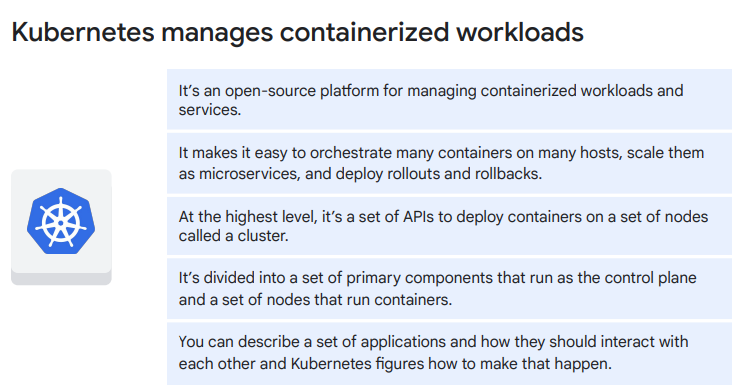We've already explore Compute Engine–which is Google Cloud's infrastructure as a
service offering, with access to servers, file systems, and networking–and App
Engine, which is Google Cloud's platform as a service offering.
What are containers?
A container is an invisible box around your code and its dependencies with limited
access to its own partition of the file system and hardware. It only requires a few
system calls to create and it starts as quickly as a process. All that’s needed on each
host is an OS kernel that supports containers and a container runtime.
In essence, the OS and dependencies are being virtualized. A container gives you the
best of two worlds - it scales like Platform as a Service (PaaS) but gives you nearly
the same flexibility as Infrastructure as a Service (IaaS.) This makes your code ultra
portable, and the OS and hardware can be treated as a black box. So you can go from
development, to staging, to production, or from your laptop to the cloud, without
changing or rebuilding anything.
In short, containers are portable, loosely coupled boxes of application code and
dependencies that allow you to “code once, and run anywhere.”
You can scale by duplicating single containers.As an example, let’s say you want to launch and then scale a web server. With a
container, you can do this in seconds and deploy dozens or hundreds of them,
depending on the size or your workload, on a single host. This is because containers
can be easily “scaled” to meet demand.
This is just a simple example of scaling one container which is running your whole
application on a single host.
A product that helps manage and scale containerized applications is Kubernetes. So
to save time and effort when scaling applications and workloads, Kubernetes can be
bootstrapped using Google Kubernetes Engine or GKE.
So, what is Kubernetes? Kubernetes is an open-source platform for managing
containerized workloads and services. It makes it easy to orchestrate many
containers on many hosts, scale them as microservices, and easily deploy rollouts
and rollbacks.
At the highest level, Kubernetes is a set of APIs that you can use to deploy containers
on a set of nodes called a cluster.
The system is divided into a set of primary components that run as the control plane
and a set of nodes that run containers. In Kubernetes, a node represents a computing
instance, like a machine. Note that this is different to a node on Google Cloud which is
a virtual machine running in Compute Engine.
You can describe a set of applications and how they should interact with each other,
and Kubernetes determines how to make that happen.
Deploying containers on nodes by using a wrapper around one or more containers is
what defines a Pod. A Pod is the smallest unit in Kubernetes that you create or deploy.
It represents a running process on your cluster as either a component of your
application or an entire app.
Generally, you only have one container per pod, but if you have multiple containers
with a hard dependency, you can package them into a single pod and share
networking and storage resources between them. The Pod provides a unique network
IP and set of ports for your containers and configurable options that govern how your
containers should run.
One way to run a container in a Pod in Kubernetes is to use the kubectl run
command, which starts a Deployment with a container running inside a Pod.
A Deployment represents a group of replicas of the same Pod and keeps your Pods
running even when the nodes they run on fail. A Deployment could represent a
component of an application or even an entire app.
To see a list of the running Pods in your project, run the command:
$ kubectl get pods
Kubernetes creates a Service with a fixed IP address for your Pods, and a controller
says "I need to attach an external load balancer with a public IP address to that
Service so others outside the cluster can access it".
In GKE, the load balancer is created as a network load balancer.
Any client that reaches that IP address will be routed to a Pod behind the Service. A
Service is an abstraction which defines a logical set of Pods and a policy by which to
access them.
As Deployments create and destroy Pods, Pods will be assigned their own IP
addresses, but those addresses don't remain stable over time.
A Service group is a set of Pods and provides a stable endpoint (or fixed IP address)
for them.
For example, if you create two sets of Pods called frontend and backend and put
them behind their own Services, the backend Pods might change, but frontend Pods
are not aware of this. They simply refer to the backend Service.
You can still reach your endpoint as before by using
kubectl get services to get
the external IP of the Service and reach the public IP address from a client.
Benefits of running GKE clusters :
Running a GKE cluster comes with the benefit of advanced cluster management
features that Google Cloud provides. These include:
● Google Cloud's load-balancing for Compute Engine instances.
● Node pools to designate subsets of nodes within a cluster for additional
flexibility.
● Automatic scaling of your cluster's node instance count.
● Automatic upgrades for your cluster's node software.
● Node auto-repair to maintain node health and availability.
● Logging and monitoring with Google Cloud Observability for visibility into your
cluster
To start up Kubernetes on a cluster in GKE, all you do is run this command:
$> gcloud container clusters create k1















No comments:
Post a Comment